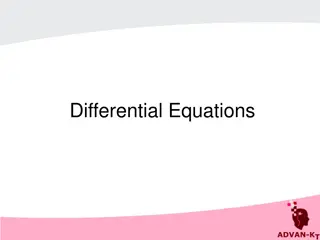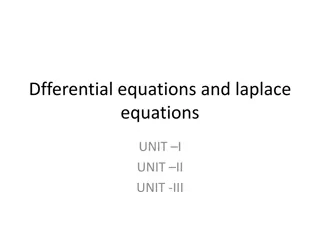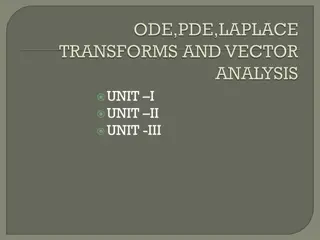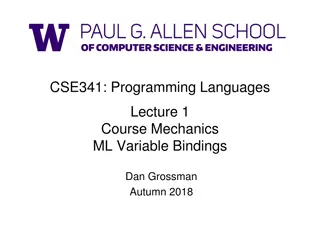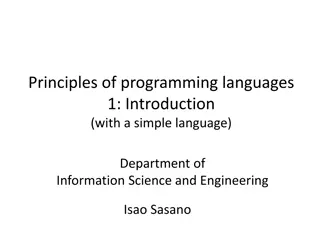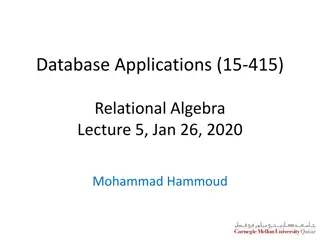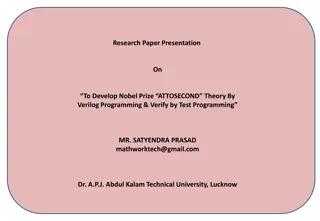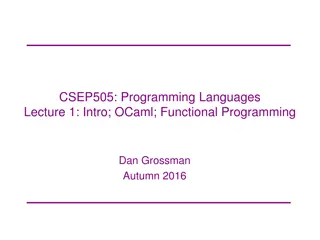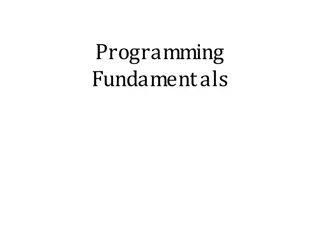Fixpoint Equations in Programming Languages
Fixpoint equations play a crucial role in programming languages for solving mutually recursive problems like parsing and dataflow analysis. This content explores the concepts of fixpoint equations, assumptions for ensuring solutions, computing solutions, and generalizations for cases with greatest elements. Examples and equations are provided to illustrate the process of solving fixpoint equations in programming.
Download Presentation

Please find below an Image/Link to download the presentation.
The content on the website is provided AS IS for your information and personal use only. It may not be sold, licensed, or shared on other websites without obtaining consent from the author.If you encounter any issues during the download, it is possible that the publisher has removed the file from their server.
You are allowed to download the files provided on this website for personal or commercial use, subject to the condition that they are used lawfully. All files are the property of their respective owners.
The content on the website is provided AS IS for your information and personal use only. It may not be sold, licensed, or shared on other websites without obtaining consent from the author.
E N D
Presentation Transcript
Goal Many problems in programming languages can be formulated as the solution of a set of mutually recursive equations: D: set, f,g:DxD D x = f(x,y) y = g(x,y) Examples Parsing: first/follow sets in SLL(k) parsing PL semantics Dataflow analysis General questions What assumptions on D, f, and g are sufficient to ensure that such a system of equations has a solution? If system has multiple solutions, which solution do we really want? How do we compute that solution? Keywords: Assumptions on D: partially-ordered set (poset), semi-lattice, lattice, complete lattice, Assumptions on functions f,g: monotonic, continuous, extensive, . Solutions: fixpoint, least fixpoint, greatest fixpoint,..
Example: SLL(1) parsing table NULLABLE = {A,B,C} FIRST(A)={x,t, } FIRST(B)={t, } FIRST(C)={v, } FIRST(S)={x,t,v,$} FOLLOW(A)={$} FOLLOW(B)={v,$} FOLLOW(C)={$} Example S A$ A BC | x B t | C v | NULLABLE, FIRST, FOLLOW computation can be formulated in terms of solving fixpoint equations
Equations for FOLLOW FOLLOW(A) T U {$} $ ??????(?) ?????? ? = ?????? ? U {$} ? ??1..?? ? ? ?????(?1..??) ? ??????(?) ? ??1..?? ? ?????? ? = ?????? ? U (????? ?1..?? ?) ? ??1..?? ? ?1,..,?? ???????? ? ??????(?) ? ??????(?) ? ??1..?? ?????? ? = ?????? ? U ??????(?) ? ?1,..,?? ????????
Computing FOLLOW sets Example S A$ A BC | x B t | C v | NULLABLE = {A,B,C} FIRST(A)={x,t, } FIRST(B)={t, } FIRST(C)={v, } FIRST(S)={x,t,v,$} FOLLOW(A)={$} FOLLOW(B)={v,$} FOLLOW(C)={$} FOLLOW: N 2T FOLLOW(A) = FOLLOW(A) U {$} FOLLOW(B) = FOLLOW(B) U {v} FOLLOW(B) = FOLLOW(B) U FOLLOW(A) FOLLOW(C) = FOLLOW(C) U FOLLOW(A) How do we solve such systems of equations?
Game plan Finite partially-ordered set with least element: D Function f: D D Monotonic function f: D D Fixpoints of monotonic function f:D D Least fixpoint Solving equation x = f(x) Least solution is least fixpoint of f Generalization to case when D has a greatest element T Least and greatest solutions to equation x = f(x) Generalization of systems of equations Semi-lattices and lattices
Partially-ordered set Set S with a binary relation < that is reflexive: x < x anti-symmetric: x < y and y < x x=y transitive: x < y and y < z x < z Example: set of integers ordered by standard < relation poset generalizes this Graphical representation of poset: Graph in which nodes are elements of S and relation < is shown by arrows Usually we omit transitive arrows to simplify picture Not a poset: S = {a,b}, {a < a, b < b, a < b, b < a} 3 2 1 0 -1 -2 -3 ..
Another example of poset {a,b,c} Powerset of any set ordered by set containment is a poset In example shown to the left, poset elements are {}, {a}, {a,b},{a,b,c}, etc. x < y if x is a subset of y {a,b} {a,c} {b,c} {a} {b} {c} { }
Finite poset with least element Poset in which set is finite there is a least element that is below all other elements in poset Examples: Set of primes ordered by natural ordering is a poset but is not finite Factors of 12 ordered by natural ordering on integers is a finite poset with least element Powerset example from previous slide is a finite poset with least element ({ }) 12 6 4 3 2 1
Domain Since finite partially-ordered set with a least element is a mouthful, we will just abbreviate it to domain . So domain is a set S and an order relation D = (S, ) Later, we will generalize the term domain to include other posets of interest to us in the context of dataflow analysis.
Functions on domains If D is a domain, f:D D a function maps each element of D to some element of D itself Examples: for D = powerset of {a,b,c} f(x) = x U {a} so f maps { } to {a}, {b} to {a,b} etc. g(x) = x {a} h(x) = {a} - x
Monotonic functions Function f: D D where D is a domain is monotonic if x < y f(x) < f(y) Common confusion: people think f is monotonic if x < f(x). This is a different property called extensivity. Intuition: think of f as an electrical circuit mapping input to output f is monotonic if increasing the input voltage causes the output voltage to increase or stay the same f is extensive if the output voltage is greater than or equal to the input voltage
Examples Domain D is powerset of {a,b,c} Monotonic functions: (x in D) x { } (why?) x x U {a} x x {a} Not monotonic: x {a} x Why? Because { } is mapped to {a} and {a} is mapped to { }. Extensivity x x U {a} is extensive and monotonic x x {a} is not extensive but monotonic Exercise: define a function on D that is extensive but not monotonic
Fixpoint of f:DD Suppose f: D D. A value x is a fixpoint of f if f(x) = x. That is, f maps x to itself. Examples: D is powerset of {a,b,c} Identity function: x x Every point in domain is a fixpoint of this function x x U {a} {a}, {a,b}, {a,c}, {a,b,c} are all fixpoints x {a} x no fixpoints
Fixpoint theorem(I) If D is a domain, is its least element, and f:D D is monotonic, then f has a least fixpoint that is the largest element in the sequence (chain) , f( ), f(f( )), f(f(f( ))), . Examples: for D = power-set of {a,b,c}, so is { } Identity function: sequence is { }, { }, { } so least fixpoint is { }, which is correct. x x U {a}: sequence is { }, {a},{a},{a}, so least fixpoint is {a} which is correct
Proof of fixpoint theorem Largest element of chain is a fixpoint: < f( ) (by definition of ) f( ) < f(f( )) (from previous fact and monotonicity of f) f(f( )) < f(f(f( ))) (same argument) we have a chain , f( ), f(f( )), f(f(f( ))), since the set D is finite, this chain cannot grow arbitrarily, so it has some largest element that f maps to itself. Therefore, we have constructed a fixpoint of f. This is the least fixpoint let p be any other fixpoint of f < p (from definition of ) So f( ) < f(p) = p (monotonicity of f) similarly f(f( )) < p etc. therefore all elements of chain are < p, so largest element of chain must be < p therefore largest element of chain is the least fixpoint of f.
Solving equations If D is a domain and f:D D is monotonic, then the equation x = f(x) has a least solution given by the largest element in the sequence , f( ), f(f( )), f(f(f( ))), Proof: follows trivially from fixpoint theorem
Easy generalization Proof goes through even if D is not a finite set but only has finite height no infinite chains .. ..
Another result If D is a domain with a greatest element T and f:D D is monotonic, then the equation x = f(x) has a greatest solution given by the smallest element in the descending sequence T, f(T), f(f(T)), f(f(f(T))), Proof: left to reader
Functions with multiple arguments If D is a domain, a function f(x,y):DxD D that takes two arguments is said to be monotonic if it is monotonic in each argument when the other argument is held constant. Intuition: electrical circuit has two inputs if you increase voltage on any one input keeping voltage on other input fixed, the output voltage stays the same or increases
Fixpoint theorem(II) If D is a domain and f,g:DxD D are monotonic, the following system of simultaneous equations has a least solution computed in the obvious way. x = f(x,y) y = g(x,y) You can easily generalize this to more than two equations and to the case when D has a greatest element T.
Formalization: product constructor Suppose D1 = (S1, 1) and D2 = (S2, 2) are domains. Define D1 x D2 to be the following domain: Set: S1 x S2 elements are pairs in which the first member is from S1 and the second is from S2 Order relation: <d1,d2> <d3,d4> if d1 1 d3 and d2 2 d4 System of equations is replaced with one equation x = f(x,y) <x,y> = foo(<x,y>) y = g(x,y) where foo is a monotonic function defined using f and g in the obvious way
Computing the least solution for a system of equations Consider x = f(x,y,z) y = g(x,y,z) z = h(x,y,z) Obvious iterative strategy: evaluate all equations at every step (Jacobi iteration) f( , , ) , g( , , ) , .. h( , , ) General approach is called round-robin scheduling of equations
Work-list based algorithm Obvious point: it is not necessary to reevaluate a function if its inputs have not changed Worklist based algorithm: initialize worklist with all equations initialize solution vector S to all while worklist not empty do get equation from worklist evaluate rhs of equation with current solution vector values and update entry corresponding to lhs variable in solution vector put all equations that use this variable in their RHS on worklist You can show that this algorithm will compute the least solution to the system of equations
Power-set domains: U and Consider a power-set domain set union and intersection are monotonic functions so we can use them in systems of fixpoints equations Example: f(x,y) = {a} Equations x = f(x,y) y = x U y Can we generalize this to domains that are not power- sets? {a,b,c} {a,b} {a,c} {b,c} {a} {b} {c} { }
Join and meet If (D, ) is po set and S D, l2 D is a lower bound of S if 8 x 2 S. l x Example: lower bounds of {c,d} are d and f In general, a given S may have many lower bounds. Greatest lower bound (glb) of S: greatest element of D that is a lower bound of S Caveat: glb may not always exist (eg) lower bounds of {b,c} are d,e,f but there is no glb If for every pair of elements x,y 2 D glb({x,y}) exists, we can define a function called meet ( :D D ! D) x y = glb({x,y}) Analogous notions: upper bounds, least upper bounds, join ( ) Meet semilattice: partially ordered set in which every pair of elements has a glb Join semilattice analogous notion Lattice: both a meet and join semilattice a b c d e f
Back to power-sets Powerset of finite set under subset ordering is classical example of a lattice Meet is set intersection Join is set union If you flip this lattice over, you get another lattice least element is {a,b,c} set union is meet set intersection is join Examples of posets that are not lattices see previous slide {a,b,c} {a,b} {a,c} {b,c} {a} {b} {c} { }
Fixpoint equations in lattices If (D, , , ) is a finite lattice, it has a least and greatest element. Meet and join functions are monotonic Therefore, if (D, , , ) is a finite lattice, fixpoint theorem (II) applies even if some of the functions f,g etc. are or Similarly, if (D, , ) is a finite, join semi- lattice, fixpoint theorem (II) applies even if some of the functions are
Back to motivating example Example S A$ A BC | x B t | C v | NULLABLE = {A,B,C} FIRST(A)={x,t, } FIRST(B)={t, } FIRST(C)={v, } FIRST(S)={x,t,v,$} FOLLOW(A)={$} FOLLOW(B)={v,$} FOLLOW(C)={$} FOLLOW: N 2T FOLLOW(A) = FOLLOW(A) U {$} FOLLOW(B) = FOLLOW(B) U {v} FOLLOW(B) = FOLLOW(B) U FOLLOW(A) FOLLOW(C) = FOLLOW(C) U FOLLOW(A) How do we solve these equations? Massage equations so there is one equation for each unknown Now we can apply any fixpoint computation technique to find least solution
Things to think about Does the equational system on previous slide have multiple solutions? If so, why is the least solution the right one for our application? If a system of fixpoint equations has multiple equations for an unknown, is the system still guaranteed to have a solution? Example: consider system x = f(x) //f and g are monotonic x = g(x)
Summary Solving systems of simultaneous equations in which the underlying structure is a partially ordered set with various properties is basic to many problems in PL usually referred to as fixpoint equations Given fairly reasonable conditions on the rhs functions and the partially ordered set, there are guaranteed to be solutions to such equations, and there are systematic ways of computing solutions keywords: join semi-lattice, meet semi-lattice, lattice,.. monotonic functions, extensive functions, continuous functions,.. round-robin algorithm, worklist algorithm







